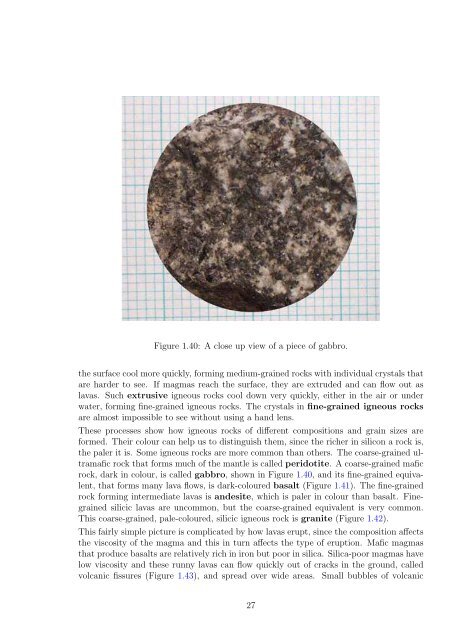The planet we live on: The beginnings of the Earth Sciences
The planet we live on: The beginnings of the Earth Sciences
The planet we live on: The beginnings of the Earth Sciences
- No tags were found...
You also want an ePaper? Increase the reach of your titles
YUMPU automatically turns print PDFs into web optimized ePapers that Google loves.
Figure 1.40: A close up view <strong>of</strong> a piece <strong>of</strong> gabbro.<strong>the</strong> surface cool more quickly, forming medium-grained rocks with individual crystals thatare harder to see. If magmas reach <strong>the</strong> surface, <strong>the</strong>y are extruded and can flow out aslavas. Such extrusive igneous rocks cool down very quickly, ei<strong>the</strong>r in <strong>the</strong> air or underwater, forming fine-grained igneous rocks. <str<strong>on</strong>g>The</str<strong>on</strong>g> crystals in fine-grained igneous rocksare almost impossible to see without using a hand lens.<str<strong>on</strong>g>The</str<strong>on</strong>g>se processes show how igneous rocks <strong>of</strong> different compositi<strong>on</strong>s and grain sizes areformed. <str<strong>on</strong>g>The</str<strong>on</strong>g>ir colour can help us to distinguish <strong>the</strong>m, since <strong>the</strong> richer in silic<strong>on</strong> a rock is,<strong>the</strong> paler it is. Some igneous rocks are more comm<strong>on</strong> than o<strong>the</strong>rs. <str<strong>on</strong>g>The</str<strong>on</strong>g> coarse-grained ultramaficrock that forms much <strong>of</strong> <strong>the</strong> mantle is called peridotite. A coarse-grained maficrock, dark in colour, is called gabbro, shown in Figure 1.40, and its fine-grained equivalent,that forms many lava flows, is dark-coloured basalt (Figure 1.41). <str<strong>on</strong>g>The</str<strong>on</strong>g> fine-grainedrock forming intermediate lavas is andesite, which is paler in colour than basalt. Finegrainedsilicic lavas are uncomm<strong>on</strong>, but <strong>the</strong> coarse-grained equivalent is very comm<strong>on</strong>.This coarse-grained, pale-coloured, silicic igneous rock is granite (Figure 1.42).This fairly simple picture is complicated by how lavas erupt, since <strong>the</strong> compositi<strong>on</strong> affects<strong>the</strong> viscosity <strong>of</strong> <strong>the</strong> magma and this in turn affects <strong>the</strong> type <strong>of</strong> erupti<strong>on</strong>. Mafic magmasthat produce basalts are relatively rich in ir<strong>on</strong> but poor in silica. Silica-poor magmas havelow viscosity and <strong>the</strong>se runny lavas can flow quickly out <strong>of</strong> cracks in <strong>the</strong> ground, calledvolcanic fissures (Figure 1.43), and spread over wide areas. Small bubbles <strong>of</strong> volcanic27
















